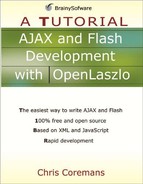About This Book
This section provides an overview of the chapters in this book.
Chapter 1, “Starting OpenLaszlo,” introduces the OpenLaszlo server, presents the first OpenLaszlo application that you write and run, and the LZX programming language that comes with OpenLaszlo. OpenLaszlo also provides a set of classes that all descend from the LzNode class.
Chapter 2, “Basic Components,” explains how to use basic components in OpenLaszlo, such as views, buttons, windows, alert boxes, combo boxes, and radio buttons.
Chapter 3, “Working with Text,” shows how you can work with text and fonts using the LzText, LzInputText, and LzFont classes.
When you add components to a container, you need to lay out those components in an appropriate manner. Chapter 4, “Layout Management,” presents various layout managers you can use in OpenLaszlo.
LZX, the language that makes OpenLaszlo tick, is an event-based language. Chapter 5, “Event Handling,” shows you how to bind objects with event handlers. You will also learn how to use the method and handler tags in this chapter.
In OpenLaszlo a constraint is the evaluation value of an expression and a state is a conditional constraint. Both provide an easy way to monitor a dynamic value and assign the value to an attribute. Chapter 6, “Constraints and States,” explains constraints and states.
Chapter 7, “Animation,” discusses how you can make animation in OpenLaszlo using the animator and animatorGroup tags. In this chapter you will also learn how to use the LzTimer class to create a timer.
Chapter 8, “Working with Data,” explains how you can access and manipulate data using XPath and the following OpenLaszlo classes: LzDataset, Grid, and LzDataPointer.
Chapter 9, “Working with Menus,” teaches you to create and use menu bars, menus, and menu items in OpenLaszlo applications. Menus are handy because they take only little space out of the user screen real estate.
Chapter 10, “Custom Drawing,” teaches how you can draw custom shapes using the LzDrawView class. Custom drawing is useful in the cases where using standard components is not sufficient.
Chapter 11, “Rich Components,” features richer components than those covered in Chapter 2. They include the following classes: Slider, DatePicker, ScrollBar, Tabs, Tabpane, and Tree.
OpenLaszlo comes with hundreds of classes that make up the framework. However, there are circumstances where you need to add more functions to an existing class or change the behavior of a class through inheritance. Chapter 12, “Extending Classes,” shows how you can achieve this.
Chapter 13, “Communicating with the Browser,” is for those who would like to deploy their OpenLaszlo applications as Flash. This chapter discusses the wrapper HTML page that embeds the Flash file and explains how to call the browser from LZX programs.
Chapter 14, “Debugging and Deployment,” explains two topics in OpenLaszlo development process. First, it teaches you how to activate the Debugger window and evaluate variable values and expressions. Second, it explains how you can easily deploy OpenLaszlo applications.
Chapter 15, “Google Maps Application,” presents a sample application that uses the Google Maps API to show various location maps.
Appendix A, “Introduction to XML,” provides a brief introduction to XML and XML document validation with DTDs and schemas.
Appendix B, “Introduction to JavaScript” provides an introduction to JavaScript.
